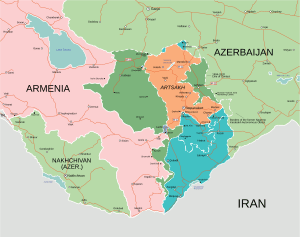2023 Nagorno-Karabakh clashes facts for kids
Quick facts for kids 2023 Nagorno-Karabakh clashes |
|||||||||
|---|---|---|---|---|---|---|---|---|---|
| Part of the Nagorno-Karabakh conflict | |||||||||
 Military situation in Nagorno-Karabakh in 2020 Areas captured by Azerbaijan during the Second Nagorno-Karabakh War Areas ceded to Azerbaijan under the 2020 ceasefire agreement Areas in Nagorno-Karabakh proper remaining under the control of Artsakh at the start of the conflict Lachin corridor and Dadivank monastery, patrolled by Russian peacekeepers |
|||||||||
|
|||||||||
| Belligerents | |||||||||
| Commanders and leaders | |||||||||
| Units involved | |||||||||
|
|
|||||||||
| Casualties and losses | |||||||||
| Unknown |
Per Artsakh:
|
||||||||
|
5 Russian peacekeepers killed by Azerbaijani forces 10 Armenian civilians killed 40 Armenian civilians injured |
|||||||||
Between 19 and 20 September 2023, in violation of the 2020 ceasefire conditions, Azerbaijan launched a large-scale military offensive against the self-declared breakaway state of Artsakh. The offensive took place in the disputed region of Nagorno-Karabakh, which is internationally recognized as a part of Azerbaijan, but populated by Armenians. The attacks occurred in the midst of an escalating crisis caused by Azerbaijan blockading the Republic of Artsakh, which has resulted in significant scarcities of essential supplies such as food, medicine, and other goods in the affected region.
One day after the offensive started, on 20 September, an agreement on establishing a complete cessation of hostilities in Nagorno-Karabakh was reached at the mediation of the Russian peacekeeping command in Nagorno-Karabakh. Azerbaijan held a meeting with representatives of the Artsakh Armenian community on 21 September in Yevlakh and a further meeting will be held the following month. Ceasefire violations by Azerbaijan were nonetheless reported by both Artsakh and local residents in Stepanakert on 21 September.
Background
The Nagorno-Karabakh conflict is an ethnic and territorial conflict between Armenia and Azerbaijan over the region of Nagorno-Karabakh, which is inhabited mostly by ethnic Armenians. The Nagorno-Karabakh region is entirely claimed by and partially de facto controlled by the breakaway Republic of Artsakh but is recognized internationally as part of Azerbaijan. Azerbaijan de facto controls one-third of Nagorno-Karabakh region as well as the seven surrounding districts.
The conflict escalated in 1988, when the Karabakh Armenians demanded the transfer of the region from Soviet Azerbaijan to Soviet Armenia, triggering the First Nagorno-Karabakh War. In late 2020, the large-scale Second Nagorno-Karabakh War resulted in thousands of casualties and a significant Azerbaijani victory. An armistice was established by a tripartite ceasefire agreement on 10 November, resulting in Armenia and Artsakh losing the territories surrounding Nagorno-Karabakh as well as one-third of Nagorno-Karabakh itself. Ceasefire violations in Nagorno-Karabakh and on the Armenian-Azerbaijani border have continued following the 2020 war, with intermittent but ongoing casualties.
Since the 2020 war, Azerbaijan has rescinded its offer of special status or autonomy to its indigenous Armenian residents and instead insists on their "integration" into Azerbaijan. International mediators and human rights organizations have emphasized self-determination for the local Armenian population and do not believe that Artsakh Armenians can live safely under the dynastic, authoritarian regime of Azerbaijani President Ilham Aliyev.
See also
 In Spanish: Enfrentamientos del Alto Karabaj de septiembre de 2023 para niños
In Spanish: Enfrentamientos del Alto Karabaj de septiembre de 2023 para niños
- List of conflicts between Azerbaijan and Armenia
- Armenia–Azerbaijan relations

